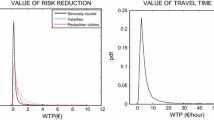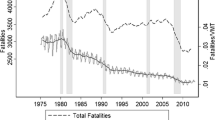Abstract
The technological approach to risk regulation seeks to lessen the incidence of mortality and morbidity by modifying environmental conditions. Insofar as risk-taking behavior is purposive, social scientists have predicted that technological progress may be negated by various forms of “risk compensation.” The validity of this hypothesis is tested in the transportation sector with data from the U.S. on the effects of new mandatory safety-belt-use laws. A fixed-effects model of traffic fatality counts is estimated using pooled data from 50 states during the 1975–1987 period. Results suggest that such laws have reduced mortality among car occupants to a degree that is compatible with the predictions of technologists. However, there is weak evidence of increased mortality among some nonoccupants, a pattern predicted by risk-compensation theorists. The lifesaving effects of belt-use laws are largest in states that permit primary police enforcement and appear to be somewhat larger for front-seat occupants age 21 and under. Although offsetting behavior appears to be small relative to lifesaving effects, it may take several more years for any compensatory behavior to achieve a new equilibrium.
Similar content being viewed by others
References
Blomquist, G.C. (1982).The Regulation of Motor Vehicle and Traffic Safety. Boston, MA: Kluwer Academic.
Campbell, B.J., J.R. Stewart, and F.A. Campbell. (1986). “Early Results of Seat Belt Legislation in the United States of America,” Working Paper, University of North Carolina Highway Safety Research Center.
Campbell, B.J., and F.A. Campbell. (1988). “Injury Reduction and Belt Use Associated with Compulsory Belt Use Legislation,” In J.D. Graham (ed.),Preventing Automobile Injury. Dover, MA: Auburn House Publishing Co.
Department of Transportation. (1984).Regulatory Impact Analysis of FMVSS 208: Occupant Crash Protection, Washington, D.C.
Evans, L. (1986). “The Effectiveness of Safety Belts in Preventing Fatalities,”Accident Analysis and Prevention 18, 229–241.
Evans, L. (1985). “Human Behavior Feedback and Traffic Safety,”Human Factors 27, 555–556.
Evans, L., P. Wasielewski, and C.R. von Buseck. (1982). “Compulsory Seat Belt Usage and Driver Risk Taking,”Human Factors 24, 41–48.
Evans, L., and P. Wasielewski. (1983). “Risky Driving Related to Driver and Vehicle Characteristics,”Accident Analysis and Prevention 15, 121–136.
Evans, W.N., and J.D. Graham. (1988). “Traffic Safety and the Business Cycle,”Alcohol, Drugs and Driving 4, 31–38.
Fuller, W.A., and G.E. Battese. (1974). “Estimation of Linear Models with Crossed-Error Structure,”Journal of Econometrics 2, 67–78.
Graham, J.D., and Younghee Lee. (1986). “Behavioral Response to Safety Regulation: The Case of Motorcycle Helmet-Wearing Legislation,”Policy Sciences 19, 253–273.
Hausman, J. (1978). “Specification Tests in Econometrics,”Econometrica 46, 1251–1276.
Judge, G.G., et al. (1980).The Theory and Practice of Econometrics. New York: John Wiley and Sons.
Latimer, E.A., and L. Lave. (1987). “Initial Effects of the New York State Auto Safety Belt Law,”American Journal of Public Health 77, 183–186.
Lund, A., and P. Zador. (1984). “Mandatory Belt Use and Driver Risk Taking,”Risk Analysis 4, 41–53.
O'Neill, B., A. Lund, and P. Zador (1985). “Mandatory Belt Use and Driver Risk-Taking: An Empirical Evaluation of the Risk-Compensation Hypothesis.” In L. Evans and R. Schwing (eds.),Human Behavior and Traffic Safety. New York: Plenum Publishing Co., pp. 93–118.
Partyka, S. (1987). “Mandatory Belt Use Laws in 1985,”Journal of the American Association for Automotive Medicine 9, 10.
Peltzman, S. (1975). “The Effects of Automobile Safety Regulation,”Journal of Political Economy 83, 667–725.
Peltzman, S. (1977). “A Reply,”Journal of Economic Issues 11, 672–678.
Wagenaar, A.C., R.G. Maybee, and K.P. Sullivan. (1987). “Effects of Mandatory Seat Belt Laws on Traffic Fatalities in the First Eight States Enacting Seat Belt Laws,” Working Paper, The University of Michigan Transportation Research Institute.
White, H. (1980). “A Heteroskedastic-Consistent Covariance Matrix Estimator and a Direct Test for Heteroskedasticity,”Econometrica 48, 817–838.
Wilde, G.J.S. (1982). “The Theory of Risk Homeostasis: Implications for Safety and Health,”Risk Analysis 2, 209–225.
Williams, A.F., and A.K. Lund. (1988). “Mandatory Seat Belt Use Laws and Occupant Crash Protection in the United States: Present Status and Future Prospects.” In John D. Graham (ed.),Preventing Automobile Injury. Dover, MA: Dover House Publishing Co.
Author information
Authors and Affiliations
Additional information
This research was supported in part by a grant from the Centers for Disease Control to the New England Injury Prevention Research Center.
Rights and permissions
About this article
Cite this article
Evans, W.N., Graham, J.D. Risk reduction or risk compensation? The case of mandatory safety-belt use laws. J Risk Uncertainty 4, 61–73 (1991). https://doi.org/10.1007/BF00057886
Issue Date:
DOI: https://doi.org/10.1007/BF00057886




